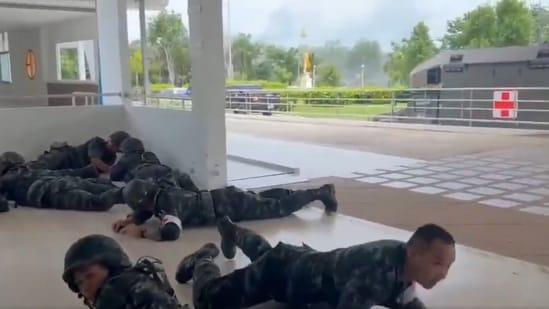A surge in violence along the Thailand-Cambodia border has left at least nine Thai civilians dead and 14 others injured in what is being called one of the gravest escalations in recent years. The situation intensified early Thursday, as both countries exchanged heavy fire in and around the disputed Emerald Triangle region.
Timeline of the Recent Clash
The conflict erupted in the early hours of Thursday, when Cambodian forces reportedly launched rockets and artillery shells into Thailand. In response, Thailand deployed F-16 fighter jets to carry out airstrikes on Cambodian military targets.
- Thursday morning: Cambodian forces fire rockets across the border.
- Midday: Thai F-16 jets scramble to strike Cambodian positions.
- Afternoon: Multiple civilian areas are hit, including a Thai hospital.
- Throughout the day: Ongoing artillery exchanges continue near the Emerald Triangle.
Although the root of the conflict lies in a long-standing border dispute, the exact cause of Thursday’s eruption remains unclear. Tensions have simmered in the region for decades, with unofficial skirmishes flaring up periodically. This most recent clash marks a new level of danger, particularly with civilian areas being targeted.
Official Statements from Thailand
The Thai government reacted swiftly to the attacks, expressing outrage at the targeting of civilian areas—including a direct strike near the Phanom Dong Rak Hospital. Footage verified by both local and international sources shows rockets landing outside the hospital’s perimeter, causing the Thai military on-site to seek cover and prompting an emergency evacuation.
“Cambodia’s relentless attacks on civilian zones, including a direct hit at Phanom Dong Rak Hospital, could not be ignored,” a spokesperson from the Foreign Ministry told CNN.
The Thai government stressed that the hospital was completely evacuated before any injuries occurred there. Still, the psychological toll and strain on healthcare services in the area are expected to be long-lasting. The hospital served several nearby villages and smaller border hamlets which are now largely cut off.
School Shutdowns and Evacuation Orders
Thai Education Minister Narumon Pinyosinwat ordered the immediate closure of schools in the Phanom Dong Rak district, a region now considered vulnerable to further military exchanges. “We have to protect the children. There is no other choice at this point,” said Pinyosinwat, according to Nation Thailand.
In addition to closing schools, emergency teams began evacuating civilians from high-risk zones by late Thursday. Roads leading out of the Emerald Triangle corridor are being used heavily by fleeing families, many of whom say they have nowhere else to go in the short term.
Understanding the Emerald Triangle Dispute
This region—where Thailand, Cambodia, and Laos converge—has been a contentious area for decades. Conflicting claims regarding national borders, minerals, and historical rights have made the area a hotbed for sporadic violence.
Though there have been multiple bilateral talks in the past, nothing lasting has materialized to resolve the dispute. Tensions typically spike during periods of nationalist fervor or political instability in either nation, but full-blown military engagements—especially ones involving civilians—are rare.
Community Response on the Ground
Reactions from residents have been mixed. Some expressed disbelief that an already tense situation had boiled over. Others said they expected this escalation for weeks. A local vendor in Phanom Dong Rak, who asked not to be named, said:
“We heard helicopters and then explosion after explosion. I grabbed my daughter and ran. There’s nothing left for us here for now.”
On social media, many Thais called for government transparency and support for the affected families. Photos and videos from the border flooded local online forums, showing both damage and the scale of the evacuation efforts underway.
Meanwhile, humanitarian organizations began setting up temporary shelters for the displaced. Many families now face uncertainty, especially those who relied on cross-border trade for their livelihoods.
Military Strategy and Global Watch
Escalating Use of Air Power
One of the key developments is Thailand’s decision to use air-strike capabilities. Scrambling F-16s in response to cross-border shelling is not common practice and indicates the Thai military is shifting to a more assertive defense strategy. Analysts say this could draw international attention and perhaps involvement by regional alliances, although no formal comments have emerged from neighboring Laos or ASEAN representatives just yet.
Military presence along the Thai-Cambodian border has quadrupled since the incident, according to sources within Thailand’s defense ministry. Both countries are reportedly reinforcing their positions, with artillery and drone deployments being monitored closely.
Global Concerns
International organizations are beginning to issue statements urging both nations to de-escalate. There are growing fears that if violence continues unchecked, it could draw in other regional players or even spark broader instability in Southeast Asia.
The UN has not formally commented yet, but experts believe it is closely monitoring the situation. Border conflicts in this region often have historic undertones, and miscalculations can easily spiral.
What’s Next?
Diplomatic talks are expected through backchannels at the Thai capital in the coming days. Yet it’s still too early to say whether calm will prevail. Many border communities are preparing for the worst. There’s a collective sense that more clarity is needed—from both governments.
What remains unspoken is how this conflict could reshape national politics on both sides. If civilian casualties mount or if critical infrastructure like hospitals or schools continues to be targeted, both governments may come under domestic pressure to act more aggressively. Or, perhaps, to retreat entirely from talks.
No one really knows yet. But as one elderly man crossing out of the zone said, dragging a torn suitcase behind him, “We’ve seen fights before. But now, it feels different.”

